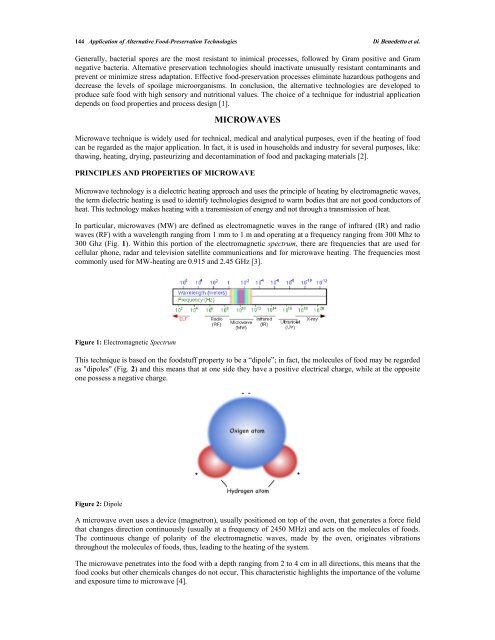application of alternative food-preservation - Bentham Science
application of alternative food-preservation - Bentham Science
application of alternative food-preservation - Bentham Science
Create successful ePaper yourself
Turn your PDF publications into a flip-book with our unique Google optimized e-Paper software.
144 Application <strong>of</strong> Alternative Food-Preservation Technologies Di Benedetto et al.<br />
Generally, bacterial spores are the most resistant to inimical processes, followed by Gram positive and Gram<br />
negative bacteria. Alternative <strong>preservation</strong> technologies should inactivate unusually resistant contaminants and<br />
prevent or minimize stress adaptation. Effective <strong>food</strong>-<strong>preservation</strong> processes eliminate hazardous pathogens and<br />
decrease the levels <strong>of</strong> spoilage microorganisms. In conclusion, the <strong>alternative</strong> technologies are developed to<br />
produce safe <strong>food</strong> with high sensory and nutritional values. The choice <strong>of</strong> a technique for industrial <strong>application</strong><br />
depends on <strong>food</strong> properties and process design [1].<br />
MICROWAVES<br />
Microwave technique is widely used for technical, medical and analytical purposes, even if the heating <strong>of</strong> <strong>food</strong><br />
can be regarded as the major <strong>application</strong>. In fact, it is used in households and industry for several purposes, like:<br />
thawing, heating, drying, pasteurizing and decontamination <strong>of</strong> <strong>food</strong> and packaging materials [2].<br />
PRINCIPLES AND PROPERTIES OF MICROWAVE<br />
Microwave technology is a dielectric heating approach and uses the principle <strong>of</strong> heating by electromagnetic waves,<br />
the term dielectric heating is used to identify technologies designed to warm bodies that are not good conductors <strong>of</strong><br />
heat. This technology makes heating with a transmission <strong>of</strong> energy and not through a transmission <strong>of</strong> heat.<br />
In particular, microwaves (MW) are defined as electromagnetic waves in the range <strong>of</strong> infrared (IR) and radio<br />
waves (RF) with a wavelength ranging from 1 mm to 1 m and operating at a frequency ranging from 300 Mhz to<br />
300 Ghz (Fig. 1). Within this portion <strong>of</strong> the electromagnetic spectrum, there are frequencies that are used for<br />
cellular phone, radar and television satellite communications and for microwave heating. The frequencies most<br />
commonly used for MW-heating are 0.915 and 2.45 GHz [3].<br />
Figure 1: Electromagnetic Spectrum<br />
This technique is based on the <strong>food</strong>stuff property to be a “dipole”; in fact, the molecules <strong>of</strong> <strong>food</strong> may be regarded<br />
as "dipoles" (Fig. 2) and this means that at one side they have a positive electrical charge, while at the opposite<br />
one possess a negative charge.<br />
Figure 2: Dipole<br />
A microwave oven uses a device (magnetron), usually positioned on top <strong>of</strong> the oven, that generates a force field<br />
that changes direction continuously (usually at a frequency <strong>of</strong> 2450 MHz) and acts on the molecules <strong>of</strong> <strong>food</strong>s.<br />
The continuous change <strong>of</strong> polarity <strong>of</strong> the electromagnetic waves, made by the oven, originates vibrations<br />
throughout the molecules <strong>of</strong> <strong>food</strong>s, thus, leading to the heating <strong>of</strong> the system.<br />
The microwave penetrates into the <strong>food</strong> with a depth ranging from 2 to 4 cm in all directions, this means that the<br />
<strong>food</strong> cooks but other chemicals changes do not occur. This characteristic highlights the importance <strong>of</strong> the volume<br />
and exposure time to microwave [4].

















